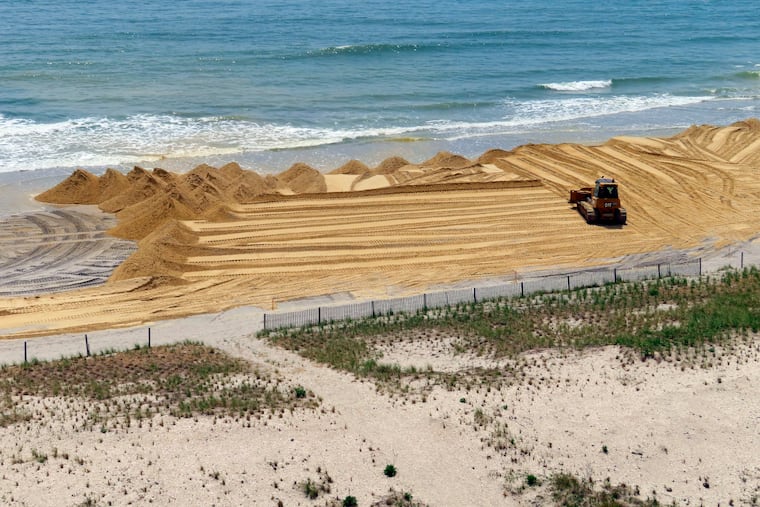Atlantic City is one of the East Coast’s disappearing cities, but rising sea levels aren’t the only factor
The problem could be made worse because New Jersey is sinking due to groundwater withdrawal and other geological factors.

Up to $20 billion worth of properties in Atlantic City could face exposure to flooding in about 25 years under sea level rise, according to new research published this month in the journal Nature.
The article on “disappearing cities” on U.S. coasts says that the sea level is projected to rise an additional 10 inches by 2050, “increasing the probability of more destructive flooding and inundation in major cities.”
But the authors wrote that the impacts might be made worse as coastal lands sink in a process known as subsidence. New Jersey is very slowly sinking due to geological conditions, as well as groundwater withdrawal. The article states that subsidence is often ignored when officials plan coastal management polices.
In other words, the dual threat of rising seas and sinking ground compound the potential for flooding.
“We have shown in this study that in most coastal areas the land is sinking, but at different rates” said lead author Leonard O. Ohenhen. “We measured that using satellite data … then we paired that with projections of sea level change by 2050 to show that significant areas of coastal cities will be affected by significant flooding if no adaptation is taken.”
» READ MORE: Climate change is coming for the Jersey Shore, retiring coastal expert warns
Sea level rise a ‘substantial challenge’
Ohenhen, a PhD candidate at Virginia Tech, and his coauthors used projections for sea level and subsidence to quantify potential flooding in 32 coastal cities. They found that up to 800 miles of land, containing up to 273,000 people and 171,000 properties, are at risk. Estimates run lower or higher depending on the level of greenhouse gas emissions projected.
The authors wrote that sea level rise will “pose a substantial socio-economic challenge” this century. The average global sea level has risen more than half a foot in the past 100 years, but that the rate of rise has only accelerated “in the early twenty-first century in response to warming temperatures.” And, even if humans manage to stabilize temperatures in coming decades, sea levels will continue to rise because of past warming, they stated.
But sea levels along the coasts are rising faster than the global average.
Overall, the authors estimate, depending on where low or high projections are used, that 176,000 to 518,000 people living in 94,000 to 288,000 properties worth $32 to $109 billion will be exposed to flood risk by 2050. The authors incorporated relative sea level rise, which takes subsidence into account, for their projections.
Of 11 cities on the Atlantic Coast, Miami, which has an average elevation of about six feet, has the greatest land mass at risk of flooding. Atlantic City ranks about fifth in terms of land mass at risk.
The value of properties facing inundation by 2050 in Miami total from $5.5 billion to $30 billion. Atlantic City falls second on the coast in that category, with properties valued at $2.8 to $20 billion.
Those values are conservative estimates, the authors say, because they don’t include infrastructure such as airports, schools, hospitals, power plants, roads, and railways.
Satellites show sinking land
Robert Kopp, a climate and sea-level scientist based at Rutgers University, was one of the peer-reviewers of the study. Kopp, who runs Rutgers’ Earth System Science and Policy Lab, was a lead author of the Intergovernmental Panel on Climate Change’s (IPCC) 2021 Sixth Assessment Report.
The Nature article says it found a better way to calculate subsidence than the IPCC had used in some reports. Kopp said the authors’ approach in using satellite imagery to make the measurements made the study unique. They showed subsidence could account for 12% to 15% of the land that falls below sea level along the Atlantic Coast by 2050. About half of that subsidence can be attributed to man-made activities, according to the authors.
“The thing about the Jersey Shore is that we know the primary reason why its sinking faster than say, Manhattan, is because of groundwater withdrawal,” Kopp noted.
Manhattan gets its drinking water from reservoirs and lakes in the Hudson Valley and Catskill Mountains. Atlantic City gets its drinking water from two reservoirs and 12 wells that run 200 to 675 feet deep.
Kopp noted that while the authors’ approach was novel, it jibes with other research. He said that in the 1950s, Atlantic City saw only one or two days of “sunny day flooding” caused by high tides, not storms, a year. NOAA research showed that had climbed to 13 days in 2021, with calls for a rise to 75 to 110 days by 2050.
» READ MORE: Philly, A.C. to see at least 5 times more ‘sunny day’ flooding in future due to sea rise
The authors of the Nature article conclude that addressing subsidence is one way to help.
“The overall goal of this study was to show the compounding effect of sinking coasts, which most people do not consider,” said Ohenhen, the lead author, “We want to try to enlighten people about how adaption will be useful in reducing the consequences.”
Part of the adaption, he said, is to regulate factors causing subsidence and create policies that keep carbon emissions low.